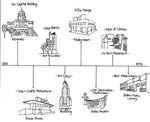
|

|
|
Home Site Search Contact Us Subscribe
|
|
The End of Design Movements We are in the greatest time of change since the Industrial Revolution. When things change, Movements happen. But is the Era of Movements over? By Duo Dickinson November 7, 2019 Landscape architect and writer Charles Jencks died a couple of weeks ago.
He was someone who connected the dots of our cultural flow in architecture. Dozens, perhaps scores of “Movements” were charted in his book The Language of Post Modern Architecture and about eight subsequent editions, plus other books.
It is a cliché to say that we are in the greatest time of change since the Industrial Revolution. But it is true. New technologies, climate change, even the nature of the American Presidency, are all promising uncontrollable evolution. The American Psychiatric Association noted that anxiety has increased for 40% of us in this time of change.
When things change, Movements happen. It’s another cliché to say that the Industrial Revolution facilitated Modernism. But it did. Instead of making buildings that looked and functioned as they had before electricity, steel, central heating, and elevators, the aesthetics of our built environment changed.
It is another cliché to say that climate change is a crisis. Crises change architecture, too. The relatively small gasoline crisis of the late 1970s caused Solar Architecture to become a Movement in the aesthetic development of architecture. While the overwhelming reality of global climate change has produced major evolutions in materials and measurables, there is no defined aesthetic impact. The buildings of 2019 look largely like those of 1979. The “Green Movement” has spawned cottage industries around USGBC ratings, “Resiliency” seminars, and a virtual Commandment of Sustainability, but the aesthetics of architecture see no break from the past.
Design criteria are not Movements.
It’s not as if architects don’t want to surf a Movement to ensure defendable designs – those in the public realm rely on the acceptable aesthetic canon to backstop their designs from second guessing. Another bromide is that Artificial Intelligence will change everything. “Parametrics” was a manifesto declared by Patrik Schumacher that simply declared that AI-driven computer aided design development would change everything. It did not.
BIM and Revit have changed everything about how we define buildings. Technologies like 3D Printing may change the way we make buildings. But these advances have not changed the what of architecture as much as the depressing boxes derived from the newly code-sanctioned “Platform Over Podium/5 over 2” construction type.
Of course, “style wars” are still a rat hole of some in architecture – that rhetorical flaming is a complete waste of time: reciting the same deeply vacuous rejection of either “Traditional” or “Modern” outcomes. But is the Era of Movements over? Are we so out of definitions as a profession that herding the cats outside the Modern Mainstream is simply impossible?
The advent of “New Music” ended any need to follow any definition of “music” beyond “sound.” Just as Modernism ended “building” for the detached description of “form.” Once the fine arts lose any connection to “how” it is made in favor of “what” is made, architecture becomes just another aesthetic vehicle.
Maybe the latest Movement in architecture is just “The Internet”: architecture designed for screen viewing. The video capture of impossibly perfect aesthetics that can be captured in 2D has made material, use, client, even context irrelevant to any verdict beyond the “swipe right” instant judgment of 2D verdicts.
There are more and more “virtual” projects being presented in print and on the Web as if they were real buildings – with only a brief allusion to their cyber reality. Instead, fetishes are foci. We see endless images of the same Wrapping Roof/Wall single-thickness layer of a mono-material, with zero visible structure and impossibly unbroken planes. Before that, is was (and is) the exquisitely extended cantilever, simply applied “just because.” We see the same void/plane boxes that have populated magazines for two generations and counting. There is nothing new being offered within these safe places, just journalism and institutionally celebrated architecture going along to get along. “Nothing to see, here, move along.”
Meanwhile, the world is exploding in change, and architects look at other architects looking at screens. In a time of change, there are few variants offered in mainstream architectural media. Having isolated alternatives Balkanizes a profession under existential threat, weakening its intellectual legitimacy. Islands of difference from the mainstream are not movements – because there is no dialogue in the mainstream, just Canon and Heresy.
Preaching to the choir is a great way to close the church. If diversity is a universal good, why can’t there be a full-on diversity of aesthetics – and a contrast of movements – in one single publication, awards program, school?
Duo Dickinson has been an architect for more than 30 years. The author of eight books, he is the architecture critic for the New Haven Register, writes on design and culture for the Hartford Courant, and is on the faculty at the Building Beauty program in Sorrento, Italy.
See also:
Lesson Plan #2: A Time of Change The coming technological changes in architecture will impose a full deconstruction of the way we educate architects. |
(click on pictures to enlarge)  patrick lee lucas / design : cosmology Design Movements/Styles Timeline |
© 2019 ArchNewsNow.com